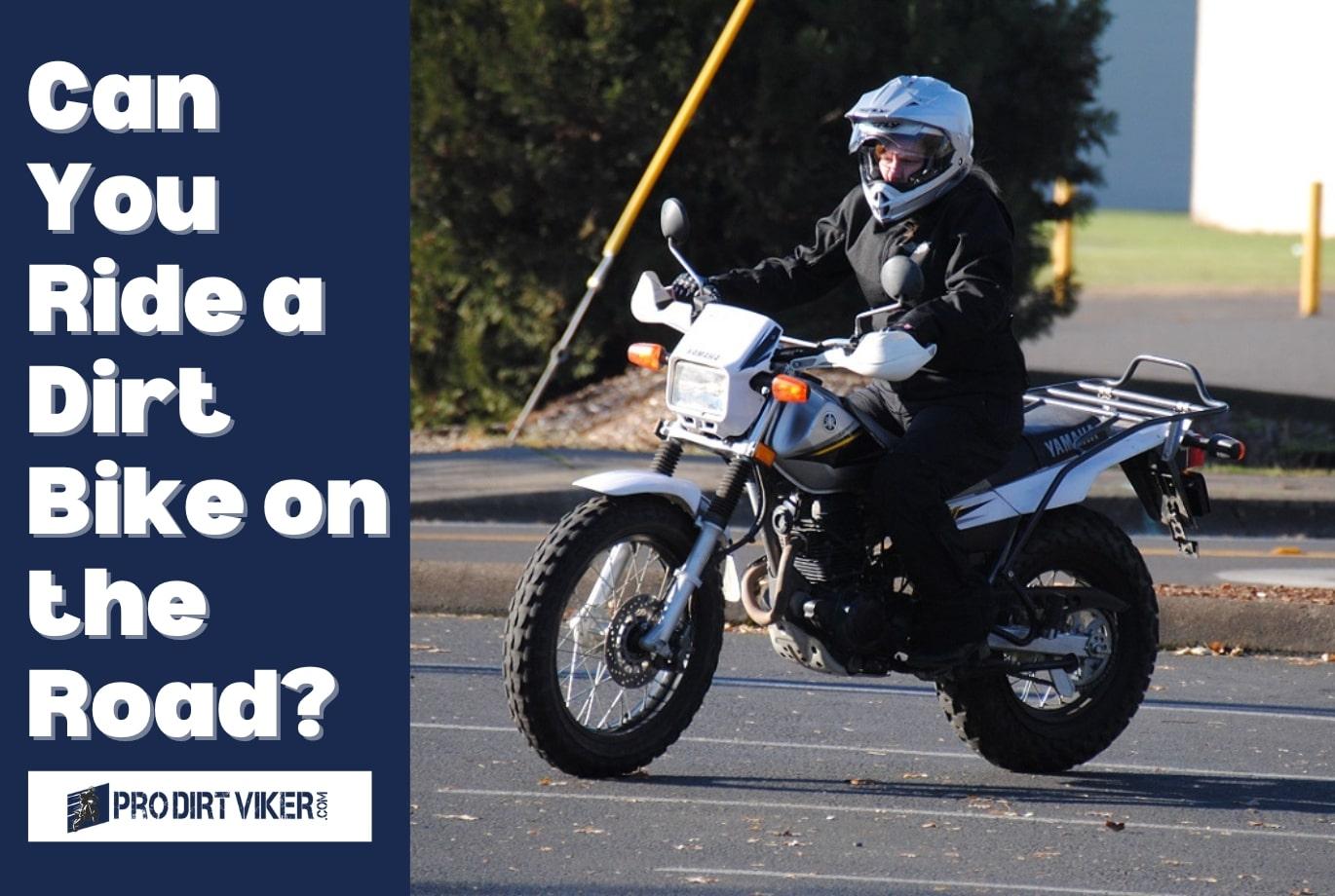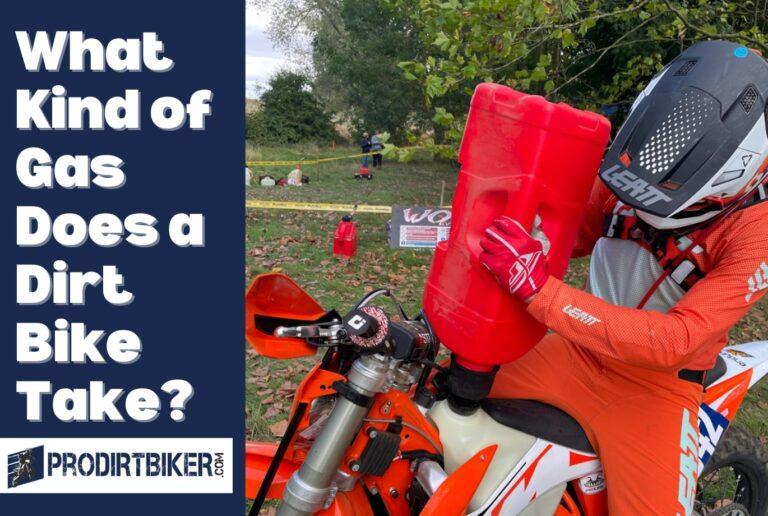Can You Ride a Dirt Bike on the Road? Exploring the Rules

Have you ever wondered if it’s possible to take your dirt bike out for a spin on the open road? Maybe you’re tired of sticking to off-road trails and want to experience the thrill of riding on pavement. In this blog post, we’ll explore the question, “Can you ride a dirt bike on the road?” and provide you with all the information you need to know.
We’ll discuss the legalities, safety considerations, and potential modifications required to make your dirt bike street-legal. So, if you’re ready to hit the road in style, keep reading!
Can You Ride a Dirt Bike on the Road?
Yes, you can ride a dirt bike on the road, but it must meet certain requirements and adhere to specific regulations. Riding a dirt bike on the road can be an exhilarating experience, offering a sense of freedom and adrenaline rush that is hard to match.
Dirt biking is an exhilarating and popular off-road sport that allows riders to navigate rugged terrain, conquer obstacles, and experience the thrill of adventure. However, many dirt bike enthusiasts often wonder whether they can take their off-road machines onto the streets and ride them on public roads. This article explores the legal and practical aspects of riding a dirt bike on the road, offering valuable insights and guidance for those considering this option.
Legal Considerations:
- Laws Vary by Location: The permissibility of riding a dirt bike on public roads largely depends on local and regional regulations. Laws can vary significantly from one place to another, so it is essential to familiarize yourself with the specific rules in your area.
- Street-Legal Modifications: Some jurisdictions permit dirt bikes on the road if they meet certain street-legal requirements. These typically include features like headlights, taillights, turn signals, mirrors, and a horn. Converting a dirt bike into a street-legal machine often involves modifications to meet these criteria.
- Licensing Requirements: To ride a dirt bike on the road legally, you may need a valid motorcycle license. The age requirement for obtaining such a license can vary, so it’s crucial to check with your local Department of Motor Vehicles (DMV) or equivalent authority.
- Vehicle Registration and Insurance: In some areas, dirt bikes ridden on public roads must be registered and insured, just like any other motor vehicle. Failure to comply with these requirements can result in fines or legal consequences.
- Noise Restrictions: Many dirt bikes produce noise levels that exceed legal limits for road use. You may need to install a muffler or other noise-reduction modifications to meet local noise regulations.
Practical Considerations:
- Road-Ready Equipment: Converting your dirt bike for road use involves equipping it with the necessary features, such as tires suitable for pavement, functioning lights, and a speedometer. Ensure your bike is in proper working condition for road safety.
- Safety Gear: Riding on the road requires proper safety gear, including a DOT-approved helmet, gloves, boots, and protective clothing. These items are crucial to protect you in case of accidents.
- Road Riding Skills: Riding on the road is different from off-road riding. It requires a different set of skills and awareness of traffic laws. Enroll in a motorcycle safety course to enhance your road-riding abilities.
- Traffic Awareness: Be aware of traffic laws and rules specific to motorcycles in your area. Understanding right-of-way, signaling, and road etiquette is essential for safe road riding.
- Maintenance: Regular maintenance is crucial when transitioning from off-road to on-road riding. Ensure your bike’s brakes, tires, lights, and other components are in top shape.
Understanding The Legal Restrictions For Riding Dirt Bikes On Public Roads
Riding a dirt bike can be an exhilarating experience, but when it comes to taking it on public roads, there are important legal restrictions to consider. Understanding these regulations is crucial to ensure you stay on the right side of the law and keep everyone safe.
In this section, we’ll explore the key points regarding the usage of dirt bikes on public roads and the various rules that apply.
Regulations On Dirt Bike Usage On Public Roads:
- Dirt bikes are primarily designed for off-road use and may not meet the necessary requirements for road use.
- In most jurisdictions, it is illegal to ride a dirt bike on public roads unless the bike is modified to meet certain safety and performance standards.
- Dirt bikes typically lack the necessary lights, signals, mirrors, and other equipment required for road use, making them incompatible with regular traffic.
Different Rules For Off-Road Vs. On-Road Bikes:
- Off-road dirt bikes are specifically designed for use on non-public and designated off-road trails, tracks, or private property.
- These bikes are not meant to be ridden on public roads and could be subject to fines or penalties if used inappropriately.
- On the other hand, there are dirt bikes that are purpose-built for road use, often referred to as dual-sport or street-legal dirt bikes.
- These bikes meet the necessary requirements to be operated on public roads, including headlights, turn signals, and other safety features.
Reviewing State-Specific Laws And Exceptions:
- While the general rule is that dirt bikes are not allowed on public roads, there may be state-specific laws and exceptions worth exploring.
- Some states, such as california, have specific regulations for off-road vehicle registration and street-legal dirt bikes.
- It’s important to research and understand the laws and regulations in your specific state or jurisdiction to ensure compliance and avoid any legal issues.
Remember, it’s always best to err on the side of caution when it comes to riding dirt bikes on public roads. Depending on your location, it may be more suitable to ride in designated off-road areas or seek out legal alternatives for road riding.
Safety should be the top priority, both for yourself and other road users, so be sure to abide by the regulations and respect the rules of the road.
Important Safety Considerations For Riding Dirt Bikes On The Road
Riding a dirt bike on the road can be an exhilarating and convenient way to get around. However, it’s crucial to prioritize safety to ensure a smooth and incident-free ride. Here are some important safety considerations to keep in mind when riding a dirt bike on the road:
Ensuring Proper Safety Gear And Attire
When hitting the road on your dirt bike, it’s essential to equip yourself with the right safety gear and attire. This includes:
- Helmet: Invest in a high-quality, properly fitting helmet to protect your head in case of a fall or collision.
- Protective clothing: Wear long-sleeved shirts, pants, and gloves made of durable materials to shield yourself from scrapes and bruises.
- Boots: Opt for sturdy boots that cover your ankles to provide ample support and protect your feet from injury.
- Eye protection: Use goggles or a face shield to shield your eyes from dust, debris, and insects.
Maintaining The Bike For Roadworthiness
Maintaining your dirt bike regularly is essential to ensure its roadworthiness and prevent any mechanical issues while riding. Prioritize the following maintenance tasks:
- Tire inspection: Regularly check the condition and pressure of your tires to ensure they are properly inflated and have sufficient tread.
- Brake maintenance: Maintain and replace brake pads and fluids as needed to ensure optimum performance and responsiveness.
- Lights and signals: Ensure that all lights and signals on your dirt bike are working correctly to ensure visibility and communicate your intentions to other road users.
- Fluid levels: Regularly check and top up all fluid levels, including oil, coolant, and fuel, to keep your bike operating smoothly.
Understanding Road Hazards And Riding Defensively
Riding a dirt bike on the road comes with its set of challenges and hazards. To stay safe, it’s crucial to understand these hazards and adopt a defensive riding approach. Here are some key points to keep in mind:
- Anticipate road conditions: Be aware of potential hazards such as potholes, loose gravel, or oil spills on the road, and adjust your riding accordingly.
- Watch for other vehicles: Keep an eye out for cars, trucks, and other vehicles on the road, and maintain a safe distance from them to avoid potential accidents.
- Use hand signals: Since dirt bikes often lack turn signals, it’s essential to use proper hand signals to indicate your intentions when turning or changing lanes.
- Be visible: Wear brightly colored and reflective clothing, especially during low-light conditions, to enhance your visibility to other road users.
By adhering to these important safety considerations, you can enjoy your dirt bike rides on the road while minimizing the risks involved. Remember, safety should always be your top priority when riding your dirt bike in a road setting. Stay alert, wear the right gear, and ride defensively to ensure a safe and enjoyable experience.

Exploring Alternative Options For Dirt Bike Enthusiasts
Dirt biking is an exhilarating activity enjoyed by enthusiasts all over the world. But what if you’re itching to hit the road on your dirt bike? Unfortunately, riding a dirt bike on the road is not legal in most places.
However, fear not! There are alternative options that can satisfy your need for off-roading excitement. Whether it’s visiting off-road parks and designated riding areas, hitting motocross tracks and organized events, or joining dirt bike clubs and communities, there are plenty of ways to keep the thrill alive.
Let’s explore these alternative options in more detail:
Off-Road Parks And Designated Riding Areas
- Off-road parks and designated riding areas are specially designated spaces where dirt bike enthusiasts can ride legally.
- These areas offer a range of terrains and trails, catering to different skill levels and preferences.
- Riders can enjoy the freedom of exploring natural landscapes without the restrictions of city roads.
- Safety measures such as protective gear and trained staff ensure a secure and enjoyable experience.
- Off-road parks and designated riding areas often have facilities like campsites or picnic areas, making them ideal for day trips or weekend getaways.
Motocross Tracks And Organized Events
- Motocross tracks provide the perfect venue for dirt bike enthusiasts to test their skills and compete with fellow riders.
- These tracks are specifically designed for off-road motorcycle racing, with challenging obstacles and jumps.
- Organized events such as races, competitions, and exhibitions are held regularly, offering an exciting and adrenaline-fueled experience.
- Riding on motocross tracks allows riders to push their limits and improve their techniques in a controlled environment.
- Participating in organized events also provides an opportunity to connect with like-minded individuals and be part of a vibrant dirt biking community.
Joining Dirt Bike Clubs And Communities
- Joining dirt bike clubs and communities is a fantastic way to share your passion with others who understand your love for off-roading.
- These clubs often organize group rides, where members explore new terrains together, fostering camaraderie and friendship.
- Riding with a group offers a sense of security and support, especially for beginners or those unfamiliar with certain areas.
- Club members can exchange valuable tips, tricks, and advice, enhancing everyone’s riding experience.
- Being part of a dirt bike club or community also opens doors to exclusive events, discounts on gear, and other perks.
Dirt bike enthusiasts need not despair if riding on the road is not an option. Off-road parks, motocross tracks, and joining clubs and communities provide ample avenues to satisfy the thirst for adventure. So gear up, and let’s explore the world of dirt biking together!
Essential Modifications For Riding A Dirt Bike On The Road
Riding a dirt bike can be an exhilarating experience, but can you take it on the road? The answer is yes, but it requires some essential modifications to ensure both safety and compliance with street legal requirements. In this section, we will explore the necessary modifications needed to ride a dirt bike on the road, including adding required safety equipment and accessories, meeting street legal requirements for lights, mirrors, and license plates, as well as adapting the bike’s suspension and tires for on-road performance.
Adding Required Safety Equipment And Accessories
To ride a dirt bike on the road, it’s crucial to equip yourself and your bike with the necessary safety gear. Here are some key points to consider:
- Helmet: Investing in a high-quality helmet is non-negotiable. Look for one that meets safety standards and provides adequate protection for your head.
- Protective wear: Don’t forget to wear proper riding gear including gloves, goggles, and boots to safeguard your hands, eyes, and feet from any potential hazards.
- Reflective clothing: Make yourself visible to other motorists on the road by wearing reflective clothing or accessories. This will help enhance your overall safety.
Street Legal Requirements For Lights, Mirrors, And License Plates
Before hitting the road, ensure that your dirt bike adheres to the street legal requirements. Take note of these important considerations:
- Lights: Your dirt bike needs to be equipped with working headlights, taillights, and turn signals. Ensure they are in good working condition and meet the prescribed brightness standards.
- Mirrors: Install functional mirrors on your dirt bike to have a clear view of your surroundings while riding on the road. Adjustable mirrors can be quite handy.
- License plate: Displaying a visible and correctly positioned license plate is crucial. Make sure it is securely mounted on your bike and complies with the legal requirements of your jurisdiction.
Adapting The Bike’S Suspension And Tires For On-Road Performance
Dirt bikes are designed for off-road terrain, so some modifications are necessary to ensure a smooth and safe ride on the road. Consider the following:
- Suspension adjustments: Modify your dirt bike’s suspension settings to accommodate the different demands of riding on paved surfaces. Stiffer suspension settings are typically recommended for better stability and handling.
- Tire selection: Switching to street legal or dual-sport tires is necessary for on-road riding. These tires provide enhanced traction and improved performance on asphalt or concrete surfaces.
To enjoy the thrill of riding your dirt bike on the road, it’s essential to adhere to the required modifications. By adding the necessary safety equipment, meeting street legal requirements, and adapting the suspension and tires, you can ride your dirt bike with confidence and enjoy the best of both worlds.
Remember to always prioritize safety and be aware of the rules and regulations in your area. So gear up and get ready to hit the road on your dirt bike adventure!
Potential Challenges And Limitations Of Using A Modified Dirt Bike On The Road
Dirt bikes are off-road vehicles designed for rugged terrains and adventurous rides. However, some riders may wonder if they can take their dirt bikes on the road for everyday commuting or recreational purposes. While it is possible to modify a dirt bike for road use, there are certain challenges and limitations that riders need to consider.
In this blog post, we will explore the potential hurdles faced when using a modified dirt bike on the road. Let’s dive in and understand the limitations in terms of speed and comfort, as well as the strain on the bike’s engine and components, and the increased maintenance and upkeep requirements.
Limitations In Terms Of Speed And Comfort:
- Dirt bikes are built for off-road use, and therefore, their design prioritizes agility, suspension, and maneuverability rather than speed and comfort.
- The gearing on dirt bikes is optimized for low-end torque, making them better suited for challenging terrains than high-speed road riding.
- The lack of wind protection, minimal seating comfort, and absence of essential road features like headlights, signals, and rearview mirrors can make long rides on a dirt bike uncomfortable and less safe.
- The relatively smaller fuel tanks on dirt bikes may necessitate frequent refueling during longer rides on the road.
Possible Strain On The Bike’S Engine And Components:
- Dirt bikes are not typically designed for sustained high-speed riding on paved surfaces. Extended periods of high rpms may result in excessive heat build-up, potentially causing engine damage or component failure.
- The suspension setup on dirt bikes is stiffer, which may not provide the desired level of comfort and control on the road, especially over bumps and uneven surfaces.
- The tires on dirt bikes are designed for off-road traction and may not offer optimal grip or stability on paved roads, compromising safety and handling.
Increased Maintenance And Upkeep Requirements:
- Riding a dirt bike on the road exposes it to more dust, gravel, and other road debris, which can accelerate wear and tear on various components.
- The constant exposure to pavement and its associated vibrations can lead to faster deterioration of bearings, suspension components, and other sensitive parts.
- Frequent maintenance tasks such as cleaning, lubrication, and inspection become crucial to ensure optimal performance and longevity of the bike when regularly ridden on paved surfaces.
By understanding these potential challenges and limitations, riders can make informed decisions about safely using a modified dirt bike on the road. It is essential to strike a balance between addressing these limitations and enjoying the unique experience that a dirt bike brings to road riding.
Advantages Of Riding A Dirt Bike On The Road
If you’re an adventurous soul who enjoys the thrill of off-roading on a dirt bike, you might be wondering if you can also take your two-wheeled companion on the road. The good news is, riding a dirt bike on the road comes with its own set of advantages.
In this blog post, we’ll explore some of the key benefits you can enjoy when you take your dirt bike for a spin on the asphalt.
Versatility For Both Off-Road And On-Road Adventures
Dirt bikes are built to handle rough terrain with ease, but that doesn’t mean they can’t handle the open road. Here are a few reasons why dirt bikes are a versatile choice for both off-road and on-road adventures:
- Lightweight design: Dirt bikes are designed to be lightweight, allowing for easy maneuverability on and off the road. This makes them a great choice for urban environments where traffic can be congested and roads can be narrow.
- Suspension system: Dirt bikes are equipped with powerful suspension systems that can handle bumps and uneven surfaces. This means you can navigate through potholes and uneven roads with minimal discomfort, ensuring a smooth ride.
- Tires: The tires on a dirt bike are designed for maximum traction, whether you’re tackling sandy trails or cruising on the road. This means you can maintain control and stability even on slippery surfaces.
Enhanced Maneuverability And Agility In Traffic
One of the greatest advantages of riding a dirt bike on the road is the enhanced maneuverability and agility it offers, especially in traffic. Here’s how a dirt bike can give you an edge on the road:
- Tight turns: Dirt bikes are known for their ability to make tight turns and weave through traffic with ease. Their nimble handling allows you to navigate congested roads and tight spaces effortlessly, saving you time and frustration.
- Acceleration: Dirt bikes are designed to provide quick and responsive acceleration, allowing you to swiftly move ahead of other vehicles in traffic. This can be particularly useful when you need to make a quick getaway or merge into a busy lane.
- Filtering through traffic: The compact size of dirt bikes makes it easier to filter through traffic, a practice commonly known as lane splitting. This can help you avoid long queues and reach your destination faster, especially during rush hour.
Access To More Scenic And Challenging Routes
While the road offers its own thrills, riding a dirt bike on the road also opens up new opportunities to explore more scenic and challenging routes. Here’s how taking your dirt bike on the road can enhance your riding experience:
- Off-road transitions: Riding on the road allows you to easily transition from one off-road trail to another, providing a seamless and diverse riding experience. You can explore different terrains and landscapes, from lush forests to rugged mountains, without needing a separate vehicle for each type of terrain.
- Remote destinations: Some of the most picturesque and remote destinations can be accessed via road, even if they require a bit of off-roading along the way. By incorporating road riding into your dirt biking adventures, you can reach hidden gems and secluded spots that wouldn’t be accessible solely off-road.
- Scenic routes: Road riding opens up the opportunity to experience breathtaking scenic routes that are often inaccessible on dirt trails. Whether it’s riding along coastal roads with stunning ocean views or cruising through mountain passes with panoramic vistas, the road offers a whole new world of scenic beauty to explore.
So, if you’ve been contemplating whether you can ride your dirt bike on the road, rest assured that it can be a rewarding and exciting experience. With their versatility, enhanced maneuverability, and access to more scenic routes, dirt bikes can take your riding adventures to a whole new level.
Buckle up, hit the road, and get ready for an adrenaline-fueled journey like no other.
Drawbacks And Potential Risks Of Riding A Dirt Bike On The Road
Do you have a dirt bike and dream of cruising down the open road? While it may seem tempting to take your dirt bike out for a spin on the streets, there are several drawbacks and potential risks to consider before doing so.
Riding a dirt bike on the road comes with its own set of challenges and dangers that you need to be aware of. In this section, we will explore the increased exposure to traffic and other road users, the higher risk of accidents and collisions, and the potential legal consequences and fines associated with riding a dirt bike on the road.
Increased Exposure To Traffic And Other Road Users
- Riding a dirt bike on the road means you will be sharing the space with other vehicles, including cars, trucks, motorcycles, and bicycles.
- Unlike off-road trails, road environments are often crowded and unpredictable, increasing your exposure to traffic and other road users.
- The higher volume of vehicles and pedestrians can make riding a dirt bike on the road more challenging, as you need to constantly be aware of your surroundings and anticipate the actions of others.
- It requires extra vigilance and quick reflexes to navigate through traffic safely, which may not be suitable for riders who are inexperienced or lack proper training.
Higher Risk Of Accidents And Collisions
- Riding a dirt bike on the road carries a higher risk of accidents and collisions compared to riding it off-road.
- The speed differential between a typical dirt bike and other vehicles on the road can lead to dangerous situations, especially on highways and busy streets.
- The limited safety features of dirt bikes, such as minimal lighting, absence of indicators, and lack of protective enclosures, make them more prone to accidents and increases the chances of serious injuries.
- Road conditions can also pose a hazard, with unpredictable obstacles like potholes, loose debris, and oil spills.
- It’s important to understand that riding a dirt bike on the road requires advanced riding skills and heightened awareness to minimize the risk of accidents.
Potential Legal Consequences And Fines
- In many jurisdictions, riding a dirt bike on the road may be prohibited or subject to specific regulations.
- Operating a dirt bike on public roads without proper licensing, registration, and insurance can result in legal consequences, including fines, impoundment of the vehicle, and even suspension of your riding privileges.
- Different jurisdictions have varying rules and restrictions governing the use of dirt bikes on the road, so it’s crucial to familiarize yourself with the local laws before taking your dirt bike out for a road ride.
- Violating traffic laws and regulations, such as speeding, reckless driving, and running red lights, can also lead to significant penalties and potential legal repercussions.
Riding a dirt bike on the road may offer a thrilling experience, but it’s essential to consider the drawbacks and potential risks involved. The increased exposure to traffic and other road users, the higher risk of accidents and collisions, and the potential legal consequences and fines should be strong considerations when deciding whether to ride your dirt bike on the road.
Always prioritize safety, adhere to local laws, and be aware of the potential hazards associated with road riding.
Frequently Asked Questions Of Can You Ride A Dirt Bike On The Road
Can You Ride A Dirt Bike On The Road Legally?
Yes, you can ride a dirt bike on the road legally if it meets certain requirements, such as registration and necessary safety features.
What Are The Requirements For Riding A Dirt Bike On The Road?
To ride a dirt bike legally on the road, you need to ensure it is registered, has working lights, mirrors, and meets emissions standards.
Do I Need A Special License To Ride A Dirt Bike On The Road?
Yes, you typically need a motorcycle license or endorsement to legally ride a dirt bike on the road.
What Modifications Are Needed To Ride A Dirt Bike On The Road?
You may need to make certain modifications to your dirt bike, such as adding turn signals and a horn, to meet road legal requirements.
What Are The Advantages Of Riding A Dirt Bike On The Road?
Riding a dirt bike on the road allows for off-road exploration, maneuverability in traffic, and a thrilling riding experience not found on standard road bikes.
Conclusion
Riding a dirt bike on the road can be a thrilling experience, but it is essential to understand and adhere to the legalities and safety precautions involved. While some countries allow dirt bikes on certain roads, many have specific regulations in place.
It is important to obtain the necessary licenses, registrations, and insurance, as well as comply with speed limits and traffic laws. Additionally, wearing appropriate safety gear, such as helmets and protective clothing, is vital to minimize the risk of injuries.
Moreover, regular maintenance and inspections of the dirt bike are crucial to ensure optimal performance and safety on the road. So, before hitting the road with your dirt bike, make sure to do thorough research and familiarize yourself with local laws and regulations, ensuring a safe and enjoyable riding experience.






